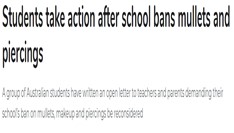Fishing for the Answer: The modern mullet and challenges to school dress codes
By Megan Kavanagh and Joel Beveridge
Where is the line between enforcing a dress code and discrimination? This article will assist in clarifying some things you, as a school, should be aware of.
In brief
Where is the line between enforcing a dress code and discrimination? This article will assist in clarifying some things you, as a school, should be aware of.
Background
Dress codes or standards have long been a part of Australian school life.
As attitudes and statutory obligations change, such standards are regularly the subject of challenge by children and staff alike.
Dress codes serve various purposes, including promoting unity, discipline, and standardising presentation. They also raise legal issues related to discrimination, accessibility and diversity.
According to the media the mullet seems to be a particular point of challenge:



In this article, we consider the current standards applicable to dress codes in Australian schools and how your code might stack up if challenged and possible responses to challenges.
Legal Framework and Obligations
Implementing and enforcing a Dress Code Policy in a school requires careful consideration of applicable legal standards.
Dress Codes have been successfully challenged where:
-
They have been inconsistently applied (Miller v Woolworths Limited (t/a Safeway)): If a dress code policy is applied unevenly or selectively, it can undermine its effectiveness and be vulnerable to legal challenges. Consistency in enforcing the policy is crucial to avoid perceptions of favouritism or discrimination.
-
The policy changed and made compliance difficult for preexisting employees (Woolworths v Dawson): When a dress code policy is introduced after an employee has been hired, it may be difficult to enforce retroactively. Preexisting employees may argue that the policy should not apply to them as it was not in place at the time they commenced their employment.
-
Poorly worded policies (Shop, Distributive and Allied Employees Association v Woolworths Limited): They are ambiguous or poorly worded. Such code can create confusion and uncertainty. Vague language can lead to inconsistent interpretations and leave the policy open to legal challenges. Clear and specific guidelines are essential to ensure clarity and enforceability.
-
Reasonable accommodation is required (Taleski v Virgin Australia International Airlines Pty Ltd): Dress code policies must account for reasonable adjustments to accommodate employees with mental illness or disabilities. Failure to make necessary accommodations can be seen as discriminatory and may result in legal consequences.
-
They are discriminatory in application (Arora v Melton Christian College): Dress code policies that discriminate against protected attributes such as gender, race, religion, disability, or sex can be deemed unlawful. For example, if different standards apply between women and men/girls and boys. Any dress code policy must be carefully designed to avoid discrimination and promote inclusivity and equality.
While these cases consider employment settings, similar rules of interpretation will apply to students and staff alike.
Reasonable Adjustments
Schools are familiar with the requirement to make reasonable adjustment in the provision of education to ensure access to education or work.
"Reasonable adjustment: is required to policies, processes, ways of work and learning unless making the adjustment would impose an unjustifiable hardship on the person" (Reurich v Club Jervis Bay Ltd [2018] FCA 1220).
In the case of Taleski v Virgin Australia International Airlines Pty Ltd, Taleski came to believe that he was suffering from a body image disorder that manifested itself in a fixation about the length of his hair. He had a profound anxiety about cutting his hair. Where Taleski did not want to cut his hair he offered to cover it to comply with the employer's dress code. The employer denied this request. It was found that the proposed adjustment was reasonable, having regard to the evidence of disability. The failure to provide adjustment was discriminatory.
Other examples of making reasonable adjustments may include allowing:
-
a person to wear non-binary dress to accommodate members of the transgender community;
-
people who might be allergic or sensitive to certain fabrics to seek alternatives; or
-
people to have tribal/cultural tattoos.
The request for reasonable adjustment should be supported by relevant documentation to demonstrate a protected attribute and the consequent need for adjustment (whether that be a medical assessment or details of cultural preference). Reasonable adjustment is not required to accommodate a preference.
When applying dress codes, schools should consider the individual circumstances and needs of students and staff with disabilities or special needs. Where evidence of accommodation is provided, consultation will be needed to ensure the accommodations are appropriate to avoid the risk of unlawful conduct and discrimination.
Gender and Uniform Policies
Dress codes may be required to accommodate individual needs and circumstances. However, such codes cannot discriminate between genders or fail to accommodate transgender and gender diverse young people.
A dress code that discriminates between boys and girls in the same school (e.g. boys must have short hair, girls can have long hair) may amount to direct discrimination based on sex.
A dress code that requires a transgender or gender diverse student or staff member to wear the specified uniform of a gender with which they do not identify may breach anti-discrimination legislation and contribute to the workers' or students' social exclusion and isolation.
The general rule for creating a dress code, is that all rules must be equally applied to all students and staff regardless of their sex or gender identity, and reasonable adjustment should be available.
In single-sex environments dress codes must not unduly discriminate against people of different ethnic or religious backgrounds.
Students need to be able to follow religious dress requirements as part of any dress code. Depending on your jurisdiction, this may not extend to the carrying of ceremonial weapons but will extend to wearing head coverings and other religious or cultural dress standards.
Students must also be able to comply with the code or standard. For example, if a policy requires children to have a 'short back and sides scissor hair cut', students with naturally curly hair may not be able to comply with such requirements and still have a neat haircut.
Hair standards continue to pose a challenge for dress codes. In Taniela v Australian Christian College Moreton Ltd [2020] QCAT 249 a complaint was made on behalf of a five-year-old boy, Cyrus Taniela, that he had been subjected to discrimination on the basis of race. Cyrus was required to cut his hair before the commencement of the second school semester of 2020 or be ‘unenrolled’. Cyrus was of Cook Island and Niuean descent and in accordance with a Cook Island custom for young boys, his hair had not been cut since birth so he could take part in a hair cutting ceremony around age seven or eight. This ceremony ‘is a male rite-of-passage that symbolises the boy’s transition to manhood’ and was planned to take place on Cyrus’s seventh birthday in September 2021 in Sydney. It was held that the requirement to have his hair cut breached the Anti-Discrimination Act 1991 (Qld).
In a more recent development, the Australian Defence Force (ADF) has embraced the decision of Captain Jesse Noble to wear a female army uniform. Presently, ADF regulations do not grant non-binary and intersex individuals the right to select their attire. However, recognising the need for inclusivity, the ADF is actively working towards implementing a new policy to provide comprehensive support to transgender, gender-affirming, non-binary, and all gender-diverse members of the defence force.
Resolving Legal Issues and Promoting Dialogue
To navigate the legal issues surrounding dress codes, schools should consider the reason for the policy, and its obligations to the community (staff and students). Schools should be open to reasonable adjustment to ensure compliance with anti-discrimination provisions. Changes to such policies should be the result of meaningful consultation with students, staff, parents, and stakeholders and must have regard to present legal obligations, including in regards to safety (be that sun safety, or other weather conditions).
Regular reviews of dress codes, conducted in consultation with stakeholders, can help identify potential legal concerns and ensure compliance with anti-discrimination laws.
However, where a variation to the uniform (for example mullets) does not relate to a cultural, religious or other protected attribute, exemption is not necessarily required.
To rely upon codes of dress, schools must enforce them consistently. Failure to do so may make it difficult to rely upon the code as setting a standard or expectation around attire. Staff should be empowered to require compliance. Consequences for non-compliance should be clear and consistently applied. Such an approach will assist in setting a culture or expectation around dress, which may, in the long term, make the policies easier to enforce.
Conclusion - Are mullets in or out?
Dress codes in Australian schools sometimes set schools apart from each other. They form part of traditions and identity of many schools. Whatever your school's approach to these matters, policies must be clear and consistently applied, but allow for reasonable accommodation when needed in respect of protected attributes.
By adopting inclusive policies, engaging in dialogue, and staying informed about the legal landscape, schools can create dress codes that comply with the law while fostering an environment where all staff and students can thrive.
However, where mullets are not part of any religious, cultural or other protected attribute under anti-discrimination law, provided that both boys, girls, and non-binary students are treated in the same way, then schools can work with communities to uphold standards of dress which are set out clearly, and applied consistently in their uniform policies.


